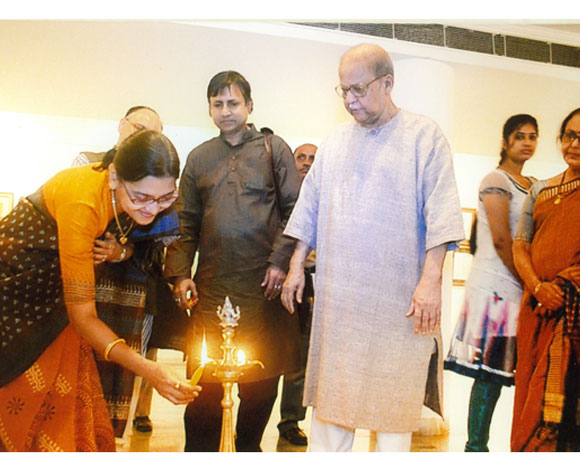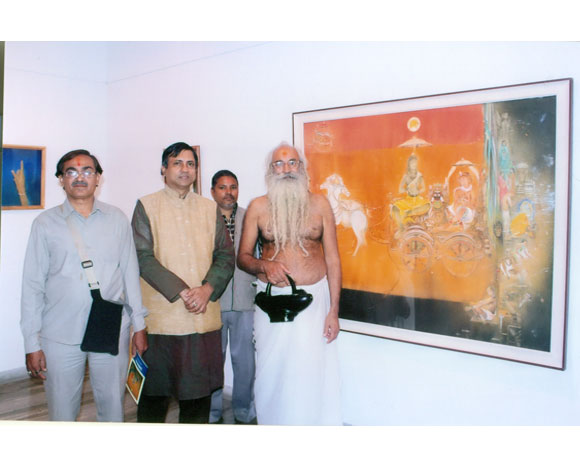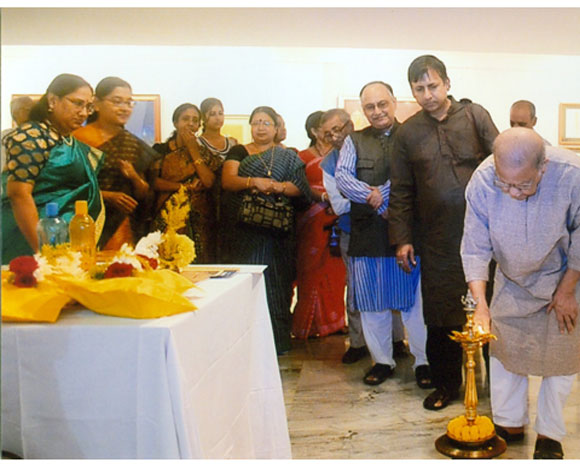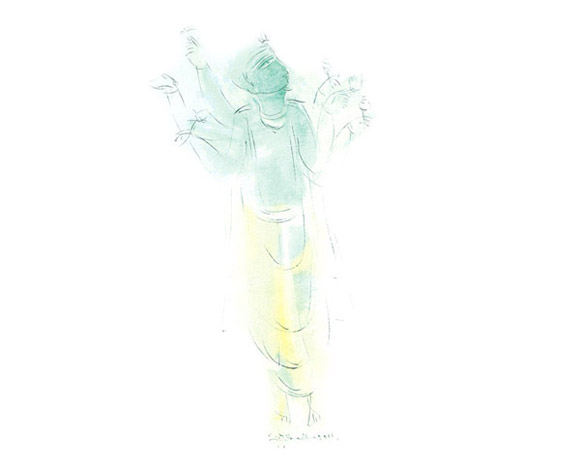
Siddhartha’s Painting – Not Just Works of Arts :
An artist, I believe, expresses himself through his works. One cannot create a work of art unless one gets immersed in his creation. A painting reveals the mind of the artist, his philosophy of life, his thought process, his personality. Siddhartha is deeply absorbed in his work. He expresses his understanding in life, world and nature by his unique brush strokes. Siddhartha’s paintings reveal an eternal quest for the unknown, an endless journey towards an undefined goal. His works show a deep and profound respect for human efforts, a warm regard for human commitment. A deep sense of spirituality pervades his entire gamut of artistic creation. His paintings chronicle the journey of the soul from the ephemeral to the eternal, from the mundane to the divine. Still he is rooted in the social reality; a deep sense of realism informs his apparently abstract work of art. Even when he dwells on traditional topics like Krishna-Chaitanya, his mode of representation is contemporary. An undercurrent of sublime spirituality permeates all his major work. Altogether it is a delight for the senses, a solace for the tortured soul – a unique and innovative intermingling of the instant and the eternity, the transient and the transcendental.
~ Ramananda Bandopadhyaya...
We, the theistic people of India, had many experiments with the idea and form of God. The henotheistic Vedic people worshipped many gods – too many gods for too many favours. This led to the ultimate frustration – who should be worshipped really – Kasmayee Debay Hobisha Bidhemo? The answer to this religio-philosophical question came from the vast literature of Upanishads which taught us the idea of One God – supreme in its power and omniscient in nature. This was Brahman. The idea of Brahman, however, was very hard to conceive. Even the learned philosophers of the Upanishads have expressed the idea of Brahman either by using a series of negatives like indefinable, inconceivable, incommunicable etc. – Asbodom Asparsham Arupom Aabopom etc., or by using contradictory adjectives like it is smaller than the smallest or greater than the greatest – Anoriaan mahoto mohiaan etc. These intellectual jargons, however, could not satisfy even the learned people, what to speak of the common mass. They felt that the supreme power required a name and definition without which one could not go for an endless meditation of underfined self. Naturally a vigorous search for a personal God with a Vedic finish and Upanishadic abstraction was very much afield – a God absolutely eternal and omniscient on one hand and powerful, active and savior on the other, a God – essentially unborn, but born when evil is on the ascendant, a God – essentially incomprehensible, but preminently exalted in human form as a loving and dear God ready to accept the veneration and love of his devotees. This search for a personal God ended with the emergence of Krishna – the black hero of the epic and the Puranas. He is omniscient, omnipotent and has all fulfillments within himself, but still he incarnated in his human form to realize the supreme bliss lying within him. He surpasses the primary motive of incarnation of saving the earth which is a common factor in other theriomorphic and anthropomorphic incarnations. This time he incarnates to take part in human sufferings, human happiness and thus enjoys the mother’s sentiment to his son, a friend’s to his friends, and above all a lover’s to his beloved. The Lord, so long half sick of his power-complex strips himself of his power-aspect (Prabhutya, Ishwaratto) through his special mystery – Yogama ya and incarnates as a total human being. He is thus no more an intellectual construction of the Upanishadic seers, nor a God of the learned philosophers like Yajnavalkya, Janaka or Svetaketu, nor even a God of the mystics, but a God of the downtrodden and devoted believers – a God of whom Pascal said in his famous creed – God of Abraham, Isaac and Jacob, not of philosophers and scholars. Such a human god who loves his devotees and can be loved by them, created a tremendous emotional effect among the poets, artists and sculptors who described, depicted and curved him in their own inimitable ways and immortalized the human elements of the black cowherd hero. The latest in this long line of artists of Siddhartha. Siddhartha with his vast experience of art and colour has approached the subject very differently. He knows that the artists so long were cought by the Lord’s majestic attitude. The extreme beauty, the extreme exuberance that so long prevailed over the life of Krishna, had been tamed down by Siddhartha. The effect of tamed and yet very glowing water colour has cast upon the Lord a human mantle which makes one feel that he is a hero, but still he is just one of us. In the Harivamsa, a post Mahabharata treatise of Krishna – the Lord himself prays to his kinsmen – not to treat him as a heavenly being but to indulge him as just one of those thousand herdsmen – Swajatiyashmi Bandhaba:. Siddhartha laid his focus on some special sports of Krishna – his nativity, his fight with poisonous Kaliya-serpent, his meeting with his beloved Radha and even his unfortunate death – being some of them. One would be readily attracted to Siddhartha’s Kaliya – damana scene. Even at the time of punishing an enemy who vitiated the atmosphere of Vrindavana and Yamuna, Krishna does not lose his charming aspect of madhurya and stands majestically in his dancing pose. No less attractive is the portrayal of the black – hero in a pastoral background. Here Krishna would be seen as if talking to his beloved herd of cattle, as is very usual with a shepherd. Radha, the embodiment of the highest mystery of Krishnaite philosophy meets her beloved in a very poetic atmosphere in Siddhartha’s painting. With peacock-feathers strewn around the black hero here offers to her heloved a garland of wild flowers. The timidly glowing water – colour from Siddhartha’s hands adds the rest of the folk elements to the cowherd hero. In fact, in all the paintings of Siddhartha it is the human element of the black hero that gets the better of the divine. This transformation towards domesticity once makes Krishna to perform the rituals of tarpana – a rare piece of painting indeed. And the ultimate artistic touch of this human flavor had been laid on the very human death-scene of the Lord. The speciality lies in the fact that the sensible artist does not and cannot present here the whole person of Krisha; instead the just draws his foot-mark – the lotus-like foot-mark which is the symbol of the ultimate truth – tad visnoh paramam padam – and it is just pierced by the non-believing hunter as is done from age to age, although the mark on the stone-slab – the truth – thee harana-chihna – shiness and shines in its own pristine glory ineffaceable by the wrath of time and non believers. And the paintings apart, only this stone-slab bearing the foot-mark of Krishna raised the whole plane of the exhibition from terrestrial to transcendental.
~ Nrisinha Prasad Bhaduri...





















